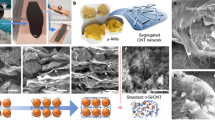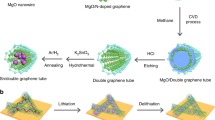Abstract
As lithium-ion batteries become ubiquitous, the energy storage market is striving for better performance, longer lifetime and better safety of the devices. This race for performance is often focused on the search for new materials, whereas less effort has been dedicated to the electrode engineering. Enhancing the power density by increasing the amount of active material remains impractical since it impinges the transport of ions across the electrode during the charging and discharging processes. Here, we show that the electrochemical performance of a battery containing a thick (about 200 μm), highly loaded (about 10 mg cm−2) graphite electrode can be remarkably enhanced by fabricating anodes with an out-of-plane aligned architecture using a low external magnetic field. The lower tortuosity resulting from such a simple and scalable magnetic alignment approach leads to a specific charge up to three times higher than that of non-architectured electrodes at a rate of 1C.
This is a preview of subscription content, access via your institution
Access options
Subscribe to this journal
Receive 12 digital issues and online access to articles
$119.00 per year
only $9.92 per issue
Buy this article
- Purchase on Springer Link
- Instant access to full article PDF
Prices may be subject to local taxes which are calculated during checkout





Similar content being viewed by others
References
Jang, S., Lee, H.-Y., Lee, S.-J., Baik, H. & Lee, S. Synthesis and electrochemical characterization of LixCoO2 for lithium-ion batteries. Mater. Res. Bull. 38, 1–9 (2003).
Badey, Q., Cherouvrier, G., Reynier, Y., Duffault, J. & Franger, S. Ageing forecast of lithium-ion batteries for electric and hybrid vehicles. Curr. Top. Electrochem. 16, 65–79 (2011).
Larcher, D. & Tarascon, J.-M. Towards greener and more sustainable batteries for electrical energy storage. Nature Chem. 7, 19–29 (2014).
Mizushima, K., Jones, P. C., Wiseman, P. J. & Goodenough, J. B. LixCoO2 (0 < x < −1): a new cathode material for batteries of high energy density. Mater. Res. Bull. 15, 783–789 (1980).
Padhi, A. K., Nanjundaswamy, K. S. & Goodenough, J. B. Phospho-olivines as positive-electrode materials for rechargeable lithium batteries. J. Electrochem. Soc. 144, 1188–1194 (1997).
Yazami, R. & Touzain, P. A reversible graphite-lithium negative electrode for electrochemical generators. J. Power Sources 9, 365–371 (1983).
Heß, M. & Novák, P. Shrinking annuli mechanism and stage-dependent rate capability of thin-layer graphite electrodes for lithium-ion batteries. Electrochim. Acta 106, 149–158 (2013).
Ren, Y., Hardwick, L. J. & Bruce, P. G. Lithium intercalation into mesoporous anatase with an ordered 3D pore structure. Angew. Chem. 49, 2570–2574 (2010).
Ren, Y. et al. Nanoparticulate TiO2(B): an anode for lithium-ion batteries. Angew. Chem. 124, 2206–2209 (2012).
Miot, J. et al. Biomineralized α-Fe2O3: texture and electrochemical reaction with Li. Energy Environ. Sci. 7, 451–460 (2014).
Taberna, P. L., Mitra, S., Poizot, P., Simon, P. & Tarascon, J.-M. High rate capabilities Fe3O4-based Cu nano-architectured electrodes for lithium-ion battery applications. Nature Mater. 5, 567–573 (2006).
Smith, K. C., Mukherjee, P. P. & Fisher, T. S. Columnar order in jammed LiFePO4 cathodes: ion transport catastrophe and its mitigation. Phys. Chem. Chem. Phys. 14, 7040–7050 (2012).
Harris, S. J. & Lu, P. Effects of inhomogeneities—nanoscale to mesoscale—on the durability of Li-ion batteries. J. Phys. Chem. C 117, 6481–6492 (2013).
Thorat, I. V. et al. Quantifying tortuosity in porous Li-ion battery materials. J. Power Sources 188, 592–600 (2009).
Pikul, J. H., Gang Zhang, H., Cho, J., Braun, P. V. & King, W. P. High-power lithium ion microbatteries from interdigitated three-dimensional bicontinuous nanoporous electrodes. Nature Commun. 4, 1732 (2013).
Zhang, H., Yu, X. & Braun, P. V. Three-dimensional bicontinuous ultrafast-charge and -discharge bulk battery electrodes. Nature Nanotech. 6, 277–281 (2011).
Ebner, M., Chung, D. W., García, R. E. & Wood, V. Tortuosity anisotropy in lithium-ion battery electrodes. Adv. Energy Mater. 4, 1301278 (2014).
Bae, C.-J., Erdonmez, C. K., Halloran, J. W. & Chiang, Y.-M. Design of battery electrodes with dual-scale porosity to minimize tortuosity and maximize performance. Adv. Mater. 25, 1254–1258 (2013).
Dunn, B., Long, J. W. & Rolison, D. R. Rethinking multifunction in three dimensions for miniaturizing electrical energy storage. Electrochem. Soc. Interface 17, 49–53 (2008).
Du, W., Xue, N., Shyy, W. & Martins, J. R. R. A. A surrogate-based multi-scale model for mass transport and electrochemical kinetics in lithium-ion battery electrodes. J. Electrochem. Soc. 161, E3086–E3096 (2014).
Tarascon, J.-M. & Armand, M. Issues and challenges facing rechargeable lithium batteries. Nature 414, 359–367 (2001).
McRae, E., Billaud, D., Marêché, J. F. & Hérold, A. Basal plane resistivity of alkali metal-graphite compounds. Physica B+C 99, 489–493 (1980).
Nemani, V. P., Harris, S. J. & Smith, K. C. Design of bi-tortuous, anisotropic graphite anodes for fast ion-transport in Li-ion batteries. J. Electrochem. Soc. 162, A1415–A1423 (2015).
García-García, R. & García, R. E. Microstructural effects on the average properties in porous battery electrodes. J. Power Sources 309, 11–19 (2016).
Wood, V. & Ebner, M. O. J. Method for the production of electrodes and electrodes made using such a method. US patent US2016/0093872 A1 (2014).
Erb, R. M., Libanori, R., Rothfuchs, N. & Studart, A. R. Composites reinforced in three dimensions by using low magnetic fields. Science 335, 199–204 (2012).
Le Ferrand, H., Bouville, F., Niebel, T. P. & Studart, A. R. Magnetically assisted slip casting of bioinspired heterogeneous composites. Nature Mater. 14, 1172–1179 (2015).
Sommer, M. R., Erb, R. M. & Studart, A. R. Injectable materials with magnetically controlled anisotropic porosity. ACS Appl. Mater. Interfaces 4, 5086–5091 (2012).
Erb, R. M., Segmehl, J., Charilaou, M., Löffler, J. F. & Studart, A. R. Non-linear alignment dynamics in suspensions of platelets under rotating magnetic fields. Soft Matter 8, 7604–7609 (2012).
Yunker, P. J., Still, T., Lohr, M. A. & Yodh, A. G. Suppression of the coffee-ring effect by shape-dependent capillary interactions. Nature 476, 308–311 (2011).
Doyle, M., Newman, J., Gozdz, A. S., Schmutz, C. N. & Tarascon, J.-M. Comparison of modeling predictions with experimental data from plastic lithium ion cells. J. Electrochem. Soc. 143, 1890–1903 (1996).
Lichtner, A. Z. et al. Dispersion, connectivity and tortuosity of hierarchical porosity composite SOFC cathodes prepared by freeze-casting. J. Eur. Ceram. Soc. 35, 585–595 (2015).
Yamaguchi, S., Asahina, H., Hirasawa, K. A., Sato, T. & Mori, S. SEI film formation on graphite anode surfaces in lithium ion battery. Mol. Cryst. Liq. Cryst. Sci. Technol. A 322, 239–244 (1998).
Billaud, D., Henry, F. X. & Willmann, P. Electrochemical synthesis of binary graphite-lithium intercalation compounds. Mater. Res. Bull. 28, 477–483 (1993).
Tran, T. D. Rate effect on lithium-ion graphite electrode performance. J. Appl. Electrochem. 26, 1161–1167 (1996).
Ebner, M. Designing Better Batteries: Visualization and Quantification of Microstructure and Degradation Mechanisms in Lithium Ion Battery Electrodes PhD thesis, ETH Zurich (2014).
Schindelin, J. et al. Fiji: an open-source platform for biological-image analysis. Nature Methods 9, 676–682 (2012).
Liu, Z. Q. Scale space approach to directional analysis of images. Appl. Opt. 30, 1369–1373 (1991).
Doube, M. et al. BoneJ: free and extensible bone image analysis in ImageJ. Bone 47, 1076–1079 (2010).
Geuzaine, C. & Remacle, J.-F. Gmsh: a 3-D finite element mesh generator with built-in pre- and post-processing facilities. Int. J. Numer. Methods Eng. 79, 1309–1331 (2009).
Acknowledgements
A.R.S. and F.B. acknowledge the financial support of the ETH Zürich and the Swiss National Science Foundation (grant 200020_146509). We are indebted to A. G. Bittermann and the Center for Optical and Electron microscopy of ETH Zürich (ScopeM) for the FIB-tomography measurement. Acknowledgements are also due to P. Novàk and N. Kränzlin for the XRD measurements, E. Maire for his contributions to the image analysis, D. Marinha for insightful discussions on ionic conductivity, and D. Billaud for sharing his knowledge on insertion compounds and ideas.
Author information
Authors and Affiliations
Contributions
Experiments were designed by J.B., F.B., T.M., C.V., A.R.S. and conducted by J.B., F.B. and T.M. T.M. and J.B. developed the slurry composition. T.M. and F.B. developed the set-up and casting method. T.M. cast the electrodes for each test. J.B. prepared the cells for the electrochemical characterization and performed all the measurements and data processing. F.B. carried out the image analysis and FIB-tomography processing. J.B., F.B. and T.M. drafted the manuscript and figures. All authors discussed the results, their implications and revised the manuscript at all stages.
Corresponding authors
Ethics declarations
Competing interests
The authors declare no competing financial interests.
Supplementary information
Supplementary Information
Supplementary Figures 1–10, Supplementary Table 1, Supplementary Notes, Supplementary Methods, Supplementary References. (PDF 6191 kb)
Rights and permissions
About this article
Cite this article
Billaud, J., Bouville, F., Magrini, T. et al. Magnetically aligned graphite electrodes for high-rate performance Li-ion batteries. Nat Energy 1, 16097 (2016). https://doi.org/10.1038/nenergy.2016.97
Received:
Accepted:
Published:
DOI: https://doi.org/10.1038/nenergy.2016.97
This article is cited by
-
Iron oxide/CNT-based artificial nacre for electromagnetic interference shielding
Nano Research (2024)
-
Extreme fast charging of commercial Li-ion batteries via combined thermal switching and self-heating approaches
Nature Communications (2023)
-
Mapping internal temperatures during high-rate battery applications
Nature (2023)
-
Lithiated metallic molybdenum disulfide nanosheets for high-performance lithium–sulfur batteries
Nature Energy (2023)
-
Strategies to enhance Li+ transference number in liquid electrolytes for better lithium batteries
Nano Research (2023)



